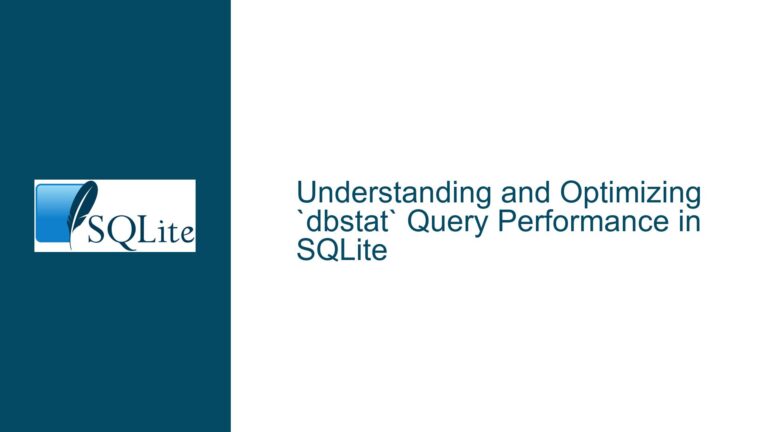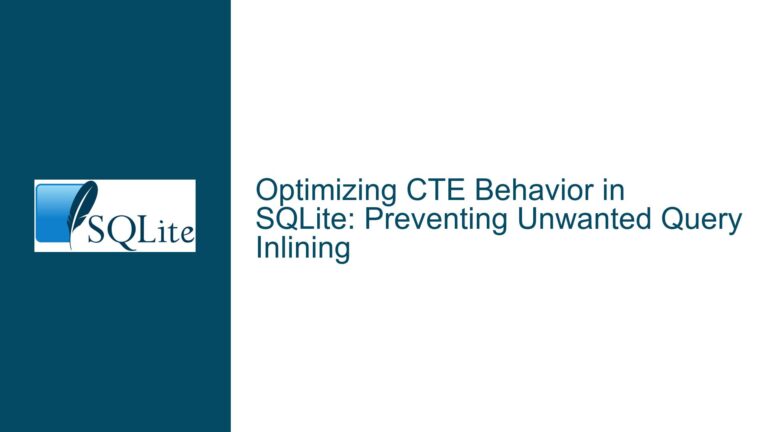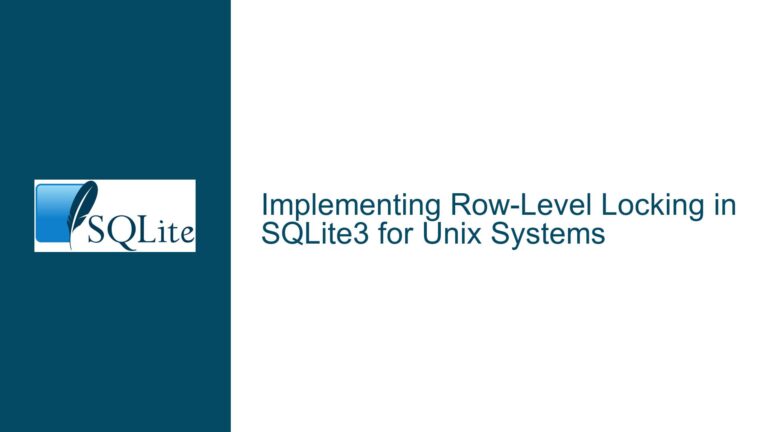Optimizing SQLite for High-Speed Bulk Inserts: Inserting One Billion Rows Under a Minute
Understanding the Challenge of High-Speed Bulk Inserts in SQLite
Inserting one billion rows into an SQLite database in under a minute is a formidable challenge that requires a deep understanding of SQLite’s internal mechanisms, optimization techniques, and the interplay between hardware and software. The primary goal is to minimize the time taken for data insertion while ensuring data integrity and consistency. This task is particularly complex due to SQLite’s architecture, which is designed for lightweight, transactional operations rather than high-speed bulk inserts. However, with careful tuning and strategic planning, it is possible to achieve this performance milestone.
The core issue revolves around the balance between transaction management, index maintenance, page cache utilization, and I/O operations. Each of these factors plays a critical role in determining the overall performance of bulk inserts. Transaction management, for instance, involves deciding when to commit changes to the database, which can significantly impact the speed of inserts. Index maintenance is another critical factor, as creating or updating indexes during the insert process can slow down performance. Page cache utilization refers to how efficiently SQLite uses memory to cache database pages, reducing the need for frequent disk I/O operations. Finally, I/O operations themselves are a bottleneck, as writing data to disk is inherently slower than in-memory operations.
To achieve the goal of inserting one billion rows in under a minute, it is essential to optimize each of these factors. This involves understanding how SQLite handles transactions, how indexes are created and maintained, how the page cache is managed, and how to minimize the impact of I/O operations. Additionally, it is important to consider the hardware environment, as the performance of SQLite is heavily influenced by the speed of the storage medium, the amount of available memory, and the processing power of the CPU.
The Role of Transaction Management in Bulk Inserts
Transaction management is one of the most critical aspects of optimizing bulk inserts in SQLite. SQLite uses a transactional model to ensure data integrity, meaning that changes to the database are not written to disk until a transaction is committed. This model provides several benefits, including the ability to roll back changes in case of an error and ensuring that the database remains in a consistent state. However, this model can also introduce significant overhead when performing bulk inserts, as each transaction involves a certain amount of processing and I/O operations.
One common approach to optimizing bulk inserts is to use a single transaction for the entire insert operation. This approach minimizes the overhead associated with starting and committing multiple transactions, as the database only needs to perform these operations once. However, this approach also has its drawbacks. If the insert operation fails midway, the entire transaction will need to be rolled back, which can be time-consuming. Additionally, using a single transaction can lead to a large amount of data being held in memory before it is written to disk, which can strain the system’s resources.
Another approach is to use smaller, batched transactions. In this approach, the insert operation is divided into smaller batches, each of which is committed separately. This approach reduces the risk of a single large transaction failing and requiring a rollback. It also allows the database to write data to disk more frequently, reducing the amount of data held in memory at any given time. However, this approach introduces additional overhead, as each batch requires its own transaction management.
The choice between these two approaches depends on several factors, including the size of the data being inserted, the available system resources, and the desired level of data integrity. In general, using a single transaction is more efficient for smaller datasets, while batched transactions are more suitable for larger datasets. However, it is important to carefully test and measure the performance of each approach in the specific context of the insert operation.
Index Maintenance and Its Impact on Bulk Insert Performance
Indexes are a critical component of any database, as they allow for faster query performance by providing a quick way to look up data. However, indexes also introduce overhead during data insertion, as the database must update the index each time a new row is inserted. This overhead can be significant, especially when performing bulk inserts, as the database must update the index for each row in the dataset.
One common strategy for optimizing bulk inserts is to defer index creation until after the data has been inserted. This approach involves creating the table without any indexes, inserting the data, and then creating the indexes. By deferring index creation, the database can avoid the overhead of updating the index during the insert operation, resulting in faster performance. However, this approach also has its drawbacks. Creating indexes after the data has been inserted can be time-consuming, especially for large datasets. Additionally, the database may need to perform a full table scan to build the index, which can be resource-intensive.
Another strategy is to disable indexes during the insert operation and then re-enable them afterward. This approach allows the database to skip index updates during the insert operation, reducing overhead. However, this approach is not always feasible, as some databases do not support disabling indexes. Additionally, re-enabling indexes after the insert operation can be time-consuming, especially for large datasets.
A third strategy is to use partial indexes or filtered indexes, which only include a subset of the data in the table. This approach can reduce the overhead of index maintenance during the insert operation, as the database only needs to update the index for the relevant rows. However, this approach is only suitable for specific use cases where the query patterns are well understood and can be optimized using partial indexes.
The choice of index maintenance strategy depends on several factors, including the size of the dataset, the complexity of the indexes, and the desired query performance. In general, deferring index creation or disabling indexes during the insert operation can provide significant performance benefits for bulk inserts. However, it is important to carefully consider the trade-offs and test the performance of each approach in the specific context of the insert operation.
Optimizing Page Cache Utilization for Bulk Inserts
The page cache is a critical component of SQLite’s performance, as it allows the database to store frequently accessed data in memory, reducing the need for disk I/O operations. During bulk inserts, the page cache plays a crucial role in determining the overall performance of the operation. If the page cache is too small, the database will need to perform frequent disk I/O operations to write data to disk, which can significantly slow down the insert operation. On the other hand, if the page cache is too large, the database may consume too much memory, leading to resource contention and potential performance degradation.
One common approach to optimizing page cache utilization is to increase the size of the page cache. This approach allows the database to store more data in memory, reducing the need for frequent disk I/O operations. However, this approach also has its drawbacks. A larger page cache can lead to increased memory usage, which can strain the system’s resources. Additionally, a larger page cache can lead to longer commit times, as the database must flush more data to disk when committing a transaction.
Another approach is to use a write-ahead log (WAL) instead of the traditional rollback journal. The WAL is a more efficient way to handle transactions, as it allows the database to write changes to a separate log file before committing them to the main database file. This approach reduces the need for frequent disk I/O operations, as the database can write changes to the WAL in a sequential manner. Additionally, the WAL allows for concurrent read and write operations, which can improve overall performance.
A third approach is to use memory-mapped I/O (mmap) to map the database file directly into memory. This approach allows the database to access the data in the file as if it were in memory, reducing the need for explicit I/O operations. However, this approach is not always feasible, as it requires the system to have sufficient memory to map the entire database file. Additionally, mmap can introduce additional complexity, as the database must manage the mapping and ensure that changes are properly synchronized with the file on disk.
The choice of page cache optimization strategy depends on several factors, including the size of the dataset, the available system resources, and the desired level of performance. In general, increasing the size of the page cache or using the WAL can provide significant performance benefits for bulk inserts. However, it is important to carefully consider the trade-offs and test the performance of each approach in the specific context of the insert operation.
Minimizing I/O Operations for Faster Bulk Inserts
I/O operations are one of the primary bottlenecks in bulk insert operations, as writing data to disk is inherently slower than in-memory operations. To achieve the goal of inserting one billion rows in under a minute, it is essential to minimize the number of I/O operations performed by the database. This can be achieved through a combination of strategies, including optimizing the page cache, using efficient transaction management, and leveraging hardware capabilities.
One common approach to minimizing I/O operations is to use a larger page cache, as discussed earlier. By storing more data in memory, the database can reduce the need for frequent disk writes, resulting in faster performance. However, this approach is limited by the amount of available memory, and it may not be feasible for very large datasets.
Another approach is to use a faster storage medium, such as an SSD or NVMe drive. These storage devices offer significantly faster read and write speeds compared to traditional hard drives, which can greatly improve the performance of bulk insert operations. However, this approach requires access to high-performance hardware, which may not be available in all environments.
A third approach is to use asynchronous I/O operations, which allow the database to continue processing data while waiting for I/O operations to complete. This approach can improve overall performance by overlapping computation and I/O, reducing the total time required for the insert operation. However, this approach introduces additional complexity, as the database must manage the asynchronous operations and ensure that data is properly synchronized.
A fourth approach is to use compression to reduce the amount of data that needs to be written to disk. By compressing the data before writing it to disk, the database can reduce the number of I/O operations required, resulting in faster performance. However, this approach introduces additional overhead, as the database must compress and decompress the data, which can impact overall performance.
The choice of I/O optimization strategy depends on several factors, including the size of the dataset, the available hardware, and the desired level of performance. In general, using a faster storage medium or asynchronous I/O operations can provide significant performance benefits for bulk inserts. However, it is important to carefully consider the trade-offs and test the performance of each approach in the specific context of the insert operation.
Leveraging Parallelism for Faster Bulk Inserts
Parallelism is another powerful tool for optimizing bulk insert operations in SQLite. By dividing the insert operation into multiple parallel tasks, the database can take advantage of multiple CPU cores and I/O channels, resulting in faster performance. However, SQLite is inherently a single-threaded database, meaning that it does not natively support parallel insert operations. To leverage parallelism, it is necessary to use external tools or techniques to divide the insert operation into multiple parallel tasks.
One common approach to leveraging parallelism is to use multiple database connections, each of which performs a portion of the insert operation. This approach allows the database to take advantage of multiple CPU cores and I/O channels, resulting in faster performance. However, this approach introduces additional complexity, as the database must manage multiple connections and ensure that data is properly synchronized between them.
Another approach is to use a multi-threaded application to perform the insert operation. In this approach, the application divides the insert operation into multiple threads, each of which performs a portion of the operation. This approach allows the application to take advantage of multiple CPU cores, resulting in faster performance. However, this approach also introduces additional complexity, as the application must manage multiple threads and ensure that data is properly synchronized between them.
A third approach is to use a distributed database system, which allows the insert operation to be divided across multiple nodes in a cluster. This approach can provide significant performance benefits for very large datasets, as the insert operation can be distributed across multiple machines. However, this approach introduces additional complexity, as the database must manage the distribution of data and ensure that data is properly synchronized between nodes.
The choice of parallelism strategy depends on several factors, including the size of the dataset, the available hardware, and the desired level of performance. In general, using multiple database connections or a multi-threaded application can provide significant performance benefits for bulk inserts. However, it is important to carefully consider the trade-offs and test the performance of each approach in the specific context of the insert operation.
Conclusion: Achieving High-Speed Bulk Inserts in SQLite
Inserting one billion rows into an SQLite database in under a minute is a challenging task that requires a deep understanding of SQLite’s internal mechanisms, optimization techniques, and the interplay between hardware and software. By carefully tuning transaction management, index maintenance, page cache utilization, and I/O operations, it is possible to achieve this performance milestone. Additionally, leveraging parallelism and using high-performance hardware can further improve the performance of bulk insert operations.
However, it is important to carefully consider the trade-offs and test the performance of each approach in the specific context of the insert operation. Each optimization strategy has its own benefits and drawbacks, and the optimal approach will depend on the specific requirements of the insert operation. By carefully analyzing the performance of each approach and making informed decisions, it is possible to achieve high-speed bulk inserts in SQLite, even for very large datasets.






